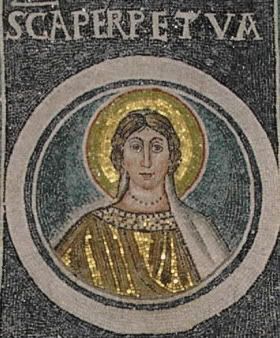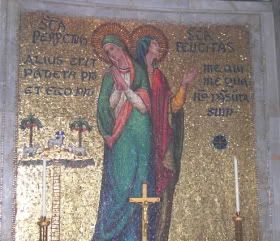
As it is often said, the blood of the martyrs is the seed of the Church. Vibia Perpetua was a young widow of the nobility in Carthage of Northern Africa. Her companions are her servants and fellow catechumens named Felicitas, Revocatus, Saturninus, Saturus, and Secundulus. Perpetua and Felicitas were both mothers–Perpetua with a newborn child, and Felicitas pregnant with child—mothers who soon found their place among the list of those early martyrs commemorated in the venerable Canon of the Roman Mass.
They were imprisoned because they had refused to offer sacrifice to the divine emperor of Rome—an act they could not reconcile with their newfound faith in God. Perpetua and her companions were later baptized while in prison, and Felicitas gave birth among the horrible conditions there. The children were adopted by fellow Christians while the accused were condemned to die by being fed to animals for the entertainment of spectators in the arena of Carthage.

While they languished in prison, Perpetua received several mystical dreams on the nights leading up to her execution. She dreamt of climbing a ladder to heaven, of visiting her dead brother, and of combating the devil. According to her memoir, she awoke from the last "understanding that I should fight not with the beasts, but with the Devil himself."
This lowly band of martyrs showed faith and courage as beasts mangled them in the arena. In the midst of their torture, their actions and words spoke only of their love of God and neighbor. Each one had their witness sealed by a sword through the throat. But the soldier who stuck Perpetua was either incapable or off-target. The thrust of his sword wounded her badly, but did not kill. While crying out in pain, with blood spilling out of her neck, Perpetua had to guide the final thrust of the sword that killed her with her own hand. The account of Perpetua’s death concludes, "Perhaps so great a woman, feared by the unclean spirit, could not have been killed unless she so willed it."

Mosaic of Perpetua and Felicitas from the Basilica Shrine
of the Immaculate Conception in Washington, DC
Our times in this land are peaceful, yet martyrdom is not a thing of the past. Indeed, more Christians were killed for their faith in the 20th Century than in the previous nineteen. It seems that we read new accounts of assaults and murders of the Christian faithful each week. We can certainly trust the assurance of St. Paul that "all who desire to live a godly life in Christ Jesus shall suffer persecution" [2 Tim 3:12]. In times of hardship, we look for God to rescue us from our afflictions.
When death seems to settle all around and close in upon us, we expect a resurrection for those faithful to the end. Sometimes we want to escape difficult things precisely when God wants to surrender. And that takes courage. We will not be disappointed in this hope for new life, but these martyrs remind us that one must first die to be resurrected. In their witness unto death, Perpetua and her companions may have shown us the source of our own beatitude—the source of our own heavenly bliss. In the face of evil and death, they joined with the author of Hebrews in saying, "We are not among those who draw back and perish, but among those who have faith and will possess life" [Hebrews 10:39].

I would love to see Mel Gibson put their story onto film.
ReplyDeleteAmen, sir. That would make a marvelous film, though I suspect he will hold off on overtly Christian films for a while so as not to be pigeon-holed.
ReplyDeleteI am intrigued by the dark-skinned icon you posted, Father. Is that a traditional Ethiopian image? I didn't know these saints were venerated there. That would be interesting. If it is a modern image, it might be worth reminding readers that Perpetua, at any rate, was herself of established Roman family and--although like Augustine born and reared in the north African littoral-probably looked more like a modern Italian than the sub-Saharan figure in the icon. While I am sure no images of Perpetua taken from life survive, there simply wasn't a great deal of interaction across the Sahara in the Roman period so she was probably primarily of colonial stock. (Though I believe some scholars think St. Monica might have had some Berber ancestry due to her unusual name.) Just a minor historical note.
I am not sure about the source. I have only come across two icons of Perpetua and Felicitas. The are pretty dark skinned in the other also, but perhaps not native African.
ReplyDeleteBTW, it looks to me like Perpetua (left) is white, while Felicitas (right) is black.
ReplyDelete